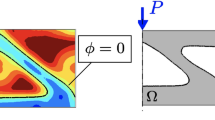Abstract
This study is devoted to a novel method for topology optimization of elastoplastic structures subjected to stress constraints. It should be noted that in spite of the classical solutions of the different type of elastoplastic topology problems are more than 70 years old, the integration of the Prandtl-Reuss constitutive equations into the topology optimization process is not very often investigated in the last three decades. In the presented methodology where the classical variational principles of plasticity and the functor-oriented programming technique are applied in topology design, the aim is to find a minimum weight structure which is able to carry a given load, fulfills the allowable stress limit, and is made of a linearly elastic, perfectly plastic material. The optimal structure is found in an iterative way using only a stress intensity distribution and a return mapping algorithm. The method determines representative stresses at every Gaussian point, averages them inside every finite element using the von Mises yield criterion, and removes material proportionally to the stress intensities in individual finite elements. The procedure is repeated until the limit load capacity is exceeded under a given loading. The effectiveness of the methodology is illustrated with three numerical examples. Additionally, different topologies are presented for a purely elastic and an elastoplastic material, respectively. It is also demonstrated that the proposed method is able to find the optimal elastoplastic topology for a problem with a computational mesh of the order of tens of thousands of finite elements.




















Similar content being viewed by others
References
Abdi M, Ashcroft I, Wildman R (2018) Topology optimization of geometrically nonlinear structures using an evolutionary optimization method. Eng Optim 50(11):1850–1870. https://doi.org/10.1080/0305215X.2017.1418864
Achtziger W, Kanzow C (2008) Mathematical programs with vanishing constraints: optimality conditions and constraint qualifications. Math Program 114:69. https://doi.org/10.1007/s10107-006-0083-3
Alberdi R, Zhang G, Li L, Khandelwal K (2018) A unified framework for nonlinear path-dependent sensitivity analysis in topology optimization. Int J Numer Methods Eng 115:1–56. https://doi.org/10.1002/nme.5794
Allaire G, Jouve F, Toader AM (2004) Structural optimization using sensitivity analysis and a level-set method. J Comput Phys 194(1):363–393. https://doi.org/10.1016/j.jcp.2003.09.032
Amir O (2017) Stress-constrained continuum topology optimization: a new approach based on elasto-plasticity. Struct Multidiscip Optim 55:1797. https://doi.org/10.1007/s00158-016-1618-8
Bendsøe MP, Kikuchi N (1988) Generating optimal topologies in structural design using a homogenization method. Comput Methods Appl Mech Eng 71(2):197–224. https://doi.org/10.1016/0045-7825(88)90086-2
Bendsøe MP (1989) Optimal shape design as a material distribution problem. Struct Optimization 1:193. https://doi.org/10.1007/BF01650949
Bendsoe M.P., Sigmund O. (2004) Topology optimization: theory, methods and applications, Springer Berlin Heidelberg, https://doi.org/10.1007/978-3-662-05086-6
Berke L., Khot N.S., (1974) Use of optimality criteria methods for large scale systems. In: AGARD Lecture Series on Structural Optimization, no.70
Biyikli E, To AC (2015) Proportional topology optimization: a new non-sensitivity method for solving stress constrained and minimum compliance problems and its implementation in MATLAB. PLoS One 10(12):e0145041. https://doi.org/10.1371/journal.pone.0145041
Blachowski B, Gutkowski W (2008) Discrete structural optimization by removing redundant material. Eng Optim 40(7):685–694. https://doi.org/10.1080/03052150801986468
Blachowski B, Gutkowski W (2010) A hybrid continuous-discrete approach to large discrete structural optimization problems. Struct Multidiscip Optim 41:965. https://doi.org/10.1007/s00158-009-0466-1
Blachowski B., Tauzowski P., Lógó J. (2019) Elasto-plastic topology optimization under stochastic loading conditions. In: Rodrigues H. et al. (eds) EngOpt 2018 Proceedings of the 6th International Conference on Engineering Optimization. EngOpt 2018. Springer, Cham
Bruggi M (2008) On an alternative approach to stress constraints relaxation in topology optimization. Struct Multidiscip Optim 36:125. https://doi.org/10.1007/s00158-007-0203-6
Changizi N, Kaboodanian H, Jalalpour M (2017) Stress-based topology optimization of frame structures under geometric uncertainty. Comput Methods Appl Mech Eng 315:121–140. https://doi.org/10.1016/j.cma.2016.10.039
Cheng GD, Guo X (1997) ε-relaxed approach in structural topology optimization. Struct Optimization 13:258. https://doi.org/10.1007/BF01197454
da Silva GA, Cardoso EL (2017) Stress-based topology optimization of continuum structures under uncertainties. Comput Methods Appl Mech Eng 313:647–672. https://doi.org/10.1016/j.cma.2016.09.049
da Silva GA, Beck AT, Sigmund O (2019) Stress-constrained topology optimization considering uniform manufacturing uncertainties. Comput Methods Appl Mech Eng 344:512–537. https://doi.org/10.1016/j.cma.2018.10.020
de Leon DM, Alexandersen J, Fonseca JSO, Sigmund O (2015) Stress-constrained topology optimization for compliant mechanism design. Struct Multidiscip Optim 52:929. https://doi.org/10.1007/s00158-015-1279-z
Duysinx P, Bendsøe MP (1998) Topology optimization of continuum structures with local stress constraints. Int J Numer Meth Engng 43:1453–1478. https://doi.org/10.1002/(SICI)1097-0207(19981230)43:8<1453::AID-NME480>3.0.CO;2-2
Eschenauer HA, Kobelev VV, Schumacher A (1994) Bubble method for topology and shape optimization of structures. Struct Optimization 8:42. https://doi.org/10.1007/BF01742933
Fin J, Borges LA, Fancello EA (2019) Structural topology optimization under limit analysis. Struct Multidiscip Optim 59:1355. https://doi.org/10.1007/s00158-018-2132-y
Fritzen F, Xia L, Leuschner M, Breitkopf P (2016) Topology optimization of multiscale elastoviscoplastic structures. Int J Numer Meth Engng 106:430–453. https://doi.org/10.1002/nme.5122
Gallagher R.H. (1973) Fully stressed design. In: Optimum Structural Design Theory and Applications, Gallagher R.H. and Zienkiewicz O.C.(Eds). 358 pp.
Guo X, Zhang WS, Wang MY, Wei P (2011) Stress-related topology optimization via level set approach, Computer Methods in Applied Mechanics and Engineering, Volume 200. Issues 47–48:3439–3452. https://doi.org/10.1016/j.cma.2011.08.016
Guo X, Zhang W, Zhong W (2014a) Doing topology optimization explicitly and geometrically—a new moving morphable components based framework. ASME J Appl Mech 81(8):081009–081009-12. https://doi.org/10.1115/1.4027609
Guo X, Zhang W, Zhong W (2014b) Stress-related topology optimization of continuum structures involving multi-phase materials. Comput Method Appl Mech Eng 268:632–655. https://doi.org/10.1016/j.cma.2013.10.003
Guo X, Zhang W, Zhang J, Yuan J (2016) Explicit structural topology optimization based on moving morphable components (MMC) with curved skeletons. Comput Methods Appl Mech Eng 310:711–748. https://doi.org/10.1016/j.cma.2016.07.018
Herfelt MA, Poulsen PN, Hoang LC (2019) Strength-based topology optimisation of plastic isotropic von Mises materials. Struct Multidiscip Optim 59:893. https://doi.org/10.1007/s00158-018-2108-y
Holmberg E, Torstenfelt B, Klarbring A (2013) Stress constrained topology optimization. Struct Multidiscip Optim 48:33. https://doi.org/10.1007/s00158-012-0880-7
James KA, Lee E, Martins JRRA (2012) Stress-based topology optimization using an isoparametric level set method. Finite Elem Anal Des 58:20–30. https://doi.org/10.1016/j.finel.2012.03.012
Jeong SH, Park SH, Choi DH, Yoon GH (2013) Toward a stress-based topology optimization procedure with indirect calculation of internal finite element information. Comput Math Appl 66(6):1065–1081. https://doi.org/10.1016/j.camwa.2013.07.008
Kaliszky S, Lógó J (1997) Optimal plastic limit and shakedown design of bar structures with constraints on plastic deformation. Eng Struct 19:19–27. https://doi.org/10.1016/S0141-0296(96)00066-1
Kato J, Hoshiba H, Takase S, Terada K, Kyoya T (2015) Analytical sensitivity in topology optimization for elastoplastic composites. Struct Multidiscip Optim 52:507. https://doi.org/10.1007/s00158-015-1246-8
Kuhn HW (2014) Nonlinear programming: a historical view. In: Giorgi G, Kjeldsen T (eds) Traces and Emergence of Nonlinear Programming. Birkhäuser, Basel
Le C, Norato J, Bruns T, Ha C, Tortorelli D (2010) Stress-based topology optimization for continua. Struct Multidiscip Optim 41:605. https://doi.org/10.1007/s00158-009-0440-y
Lee JW, Yoon GH (2017) Stress based topology optimization of reinforcement structure under in-plane load. Comput Struct 191:115–128. https://doi.org/10.1016/j.compstruc.2017.05.009
Lewiński T, Sokół T, Graczykowski C (2019) Michell structures. Springer International Publishing, Cham. https://doi.org/10.1007/978-3-319-95180-5
Li L, Khandelwal K (2017) Design of fracture resistant energy absorbing structures using elastoplastic topology optimization. Struct Multidiscip Optim 56:1447. https://doi.org/10.1007/s00158-017-1735-z
Li L, Zhang G, Khandelwal K (2017a) Design of energy dissipating elastoplastic structures under cyclic loads using topology optimization. Struct Multidiscip Optim 56:391. https://doi.org/10.1007/s00158-017-1671-y
Li L, Zhang G, Khandelwal K (2017b) Topology optimization of energy absorbing structures with maximum damage constraint. Int J Numer Meth Engng 112:737–775. https://doi.org/10.1002/nme.5531
Li L, Zhang G, Khandelwal K Struct Multidisc Optim (2018) 58: 1589. https://doi.org/10.1007/s00158-018-1984-5
Lógó J, Balogh B, Pintér E (2018) Topology optimization considering multiple loading. Comput Struct 207:233–244. https://doi.org/10.1016/j.compstruc.2017.03.018
Luo Y, Kang Z (2012) Topology optimization of continuum structures with Drucker–Prager yield stress constraints. Comput Struct 90–91:65–75. https://doi.org/10.1016/j.compstruc.2011.10.008
Martínez-Frutos J, Martínez-Castejón PJ, Herrero-Pérez D (2017) Efficient topology optimization using GPU computing with multilevel granularity. Adv Eng Softw 106:47–62. https://doi.org/10.1016/j.advengsoft.2017.01.009
Maute K, Schwarz S, Ramm E (1998) Adaptive topology optimization of elastoplastic structures. Struct Optimization 15:81. https://doi.org/10.1007/BF01278493
Maxwell J (1870) I.—On reciprocal figures, frames, and diagrams of forces. Trans Royal Soc Edinburgh 26(1):1–40. https://doi.org/10.1017/S0080456800026351
Michell AGM (1904) LVIII. The limits of economy of material in frame-structures, The London, Edinburgh, and Dublin Philosophical Magazine. J Sci 8(47):589–597. https://doi.org/10.1080/14786440409463229
Navarrina F, Muiños I, Colominas I, Casteleiro M (2005) Topology optimization of structures: a minimum weight approach with stress constraints. Adv Eng Softw 36(9):599–606. https://doi.org/10.1016/j.advengsoft.2005.03.005
Noël L, Duysinx P, Maute K (2017) Level set topology optimization considering damage. Struct Multidiscip Optim 56:737. https://doi.org/10.1007/s00158-017-1724-2
Picelli R, Townsend S, Brampton C, Norato J, Kim HA (2018) Stress-based shape and topology optimization with the level set method. Comput Method Appl Mech Eng 329:1–23. https://doi.org/10.1016/j.cma.2017.09.001
Rozvany GIN (ed) (1992) Shape and layout optimization of structural systems and optimality criteria methods. Springer Vienna, Vienna. https://doi.org/10.1007/978-3-7091-2788-9
Rozvany GIN (2009) A critical review of established methods of structural topology optimization. Struct Multidiscip Optim 37:217. https://doi.org/10.1007/s00158-007-0217-0
Save MA (1983) Remarks on minimum-volume designs of a three-bar truss. J Struct Mech 11(1):101–110. https://doi.org/10.1080/03601218308907434
Sharma A, Maute K (2018) Stress-based topology optimization using spatial gradient stabilized XFEM. Struct Multidiscip Optim 57:17. https://doi.org/10.1007/s00158-017-1833-y
Sigmund O, Maute K (2013) Topology optimization approaches: a comparative review. Struct Multidiscip Optim 48(6):1031–1055. https://doi.org/10.1007/s00158-013-0978-6
Simonetti HL, Almeida VS, das Neves FA (2018) Smoothing evolutionary structural optimization for structures with displacement or natural frequency constraints. Eng Struct 163:1–10. https://doi.org/10.1016/j.engstruct.2018.02.032
Sun J, Tian Q, Hu H (2017) Topology optimization of a three-dimensional flexible multibody system via moving morphable components. ASME J Comput Nonlinear Dynam 13(2):021010–021010-11. https://doi.org/10.1115/1.4038142
Tauzowski P, Kleiber M (2006) Parameter and shape sensitivity of thermo-viscoelastic response, Computers & Structures, Volume 84. Issues 5–6:385–399. https://doi.org/10.1016/j.compstruc.2005.09.026
Tauzowski P, Blachowski B, Lógó J (2019) Functor-oriented topology optimization of elasto-plastic structures. Adv Eng Softw 135:102690. https://doi.org/10.1016/j.advengsoft.2019.102690
Xia L, Fritzen F, Breitkopf P (2017) Evolutionary topology optimization of elastoplastic structures. Struct Multidiscip Optim 55:569 https://doi.org/10.1007/s00158-016-1523-1
Xie YM, Steven GP (1993) A simple evolutionary procedure for structural optimization. Comput Struct 49(5):885–896. https://doi.org/10.1016/0045-7949(93)90035-C
Yang D, Liu H, Zhang W, Li S (2018) Stress-constrained topology optimization based on maximum stress measures. Comput Struct 198:23–39. https://doi.org/10.1016/j.compstruc.2018.01.008
Zhang W, Yuan J, Zhang J, Guo X (2016a) A new topology optimization approach based on Moving Morphable Components (MMC) and the ersatz material model. Struct Multidiscip Optim 53:1243. https://doi.org/10.1007/s00158-015-1372-3
Zhang W, Yang W, Zhou J, Li D, Guo X (2016b) Structural topology optimization through explicit boundary evolution. ASME J Appl Mech 84(1):011011–011011-10. https://doi.org/10.1115/1.4034972
Zhang S, Gain AL, Norato JA (2017) Stress-based topology optimization with discrete geometric components. Comput Methods Appl Mech Eng 325:1–21. https://doi.org/10.1016/j.cma.2017.06.025
Zuo ZH, Xie YM (2015) A simple and compact Python code for complex 3D topology optimization. Adv Eng Softw 85:1–11. https://doi.org/10.1016/j.advengsoft.2015.02.006
Acknowledgments
The present study was supported by the National Research, Development and Innovation Office (grant K 119440) - Joint grant of the Hungarian and the Polish Academy of Sciences.
Author information
Authors and Affiliations
Corresponding author
Ethics declarations
Conflict of interest
The authors declare that they have no conflict of interest.
Replication of results
The proposed method for topology optimization is based on classical elastoplastic finite element analysis. The implementation together with all necessary formulas has been described in details in Sect. 3 of this paper. Additionally, all the necessary data to reproduce the results reported here are provided in section called “Numerical examples.”
Additional information
Responsible Editor: Xu Guo
Publisher’s note
Springer Nature remains neutral with regard to jurisdictional claims in published maps and institutional affiliations.
Rights and permissions
About this article
Cite this article
Blachowski, B., Tauzowski, P. & Lógó, J. Yield limited optimal topology design of elastoplastic structures. Struct Multidisc Optim 61, 1953–1976 (2020). https://doi.org/10.1007/s00158-019-02447-9
Received:
Revised:
Accepted:
Published:
Issue Date:
DOI: https://doi.org/10.1007/s00158-019-02447-9




